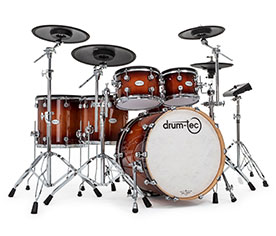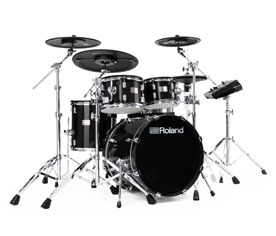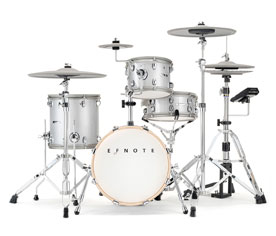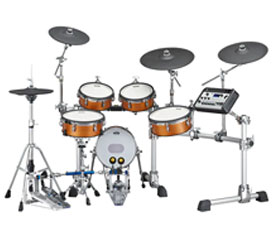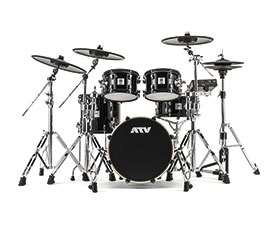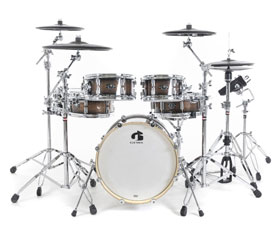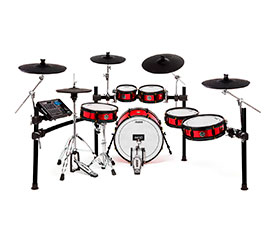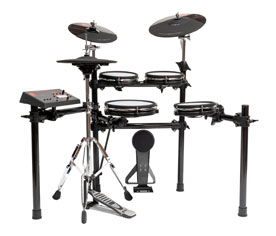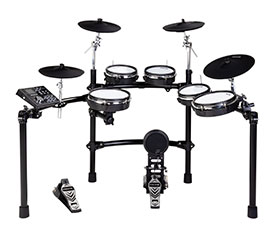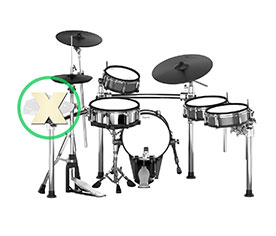What are e-drums?
E-drums are the electronic/digital versions of a drum kit. An electronic drum kit, like its acoustic counterpart, is played with sticks and a pedal. The difference is - as with acoustic and electric guitars, for example - the creation of the sound. It does not come directly from the drum. Each hit triggers a signal, which is transmitted to a sound module. There, the sound is processed and generated.
The history of e-drums
What has long been possible for other musicians, like guitarists or pianists, was withheld from drummers for a long time: an electronic version of the instrument. The pioneer of electronic drums was the Simmons company in the early 1980s. From there, the development of e-drums had its way.
Milestones to the modern e-set:
- In 1983, the BOSS company invented the HC-2, a simple pad that produced a "clap." Other pads with a similar design (HCK-100, PC-2 from Amtek) followed at the same time.
- 1985 Roland presented the first electronic drum kit, yet without cymbals
- Also in 1985 Roland introduced the first Octapad (Pad-8): A drum module with 8 pads attached to it1987 followed the successor, which already resembled the sound of an acoustic set.
- The big breakthrough was still denied to e-drums, because they were lacking a natural rebound and techniques like rolls could not be realized.
- In 1993, the introduction of rubber pads improved the feel of the drums, as they came closer to the characteristics of an acoustic drum set.
- Additionally, in the same year a hi-hat control pedal was released that imitated the sound of a closing hi-hat
- Somewhat later the introduction of the Mesh Heads followed: Fine mesh plastic grids that could be played like acoustic heads
- In 2001, the first e-cymbals appeared on the market. From this point on, it was possible to speak of a complete electronic drum kit for the first time.
Today's e-drums have very little in common with their early pioneers. They are high-tech computers that can store thousands of sounds that can be assigned to the pads and cymbals as desired. Here, the technology does an almost perfect balancing act between acoustic and synthetic sounds.
And also visually a lot has changed...
Conventional vs. Acoustic Design
While the hexagonal plastic pads of the mid-1980s visually didn't have a lot in common with an acoustic drum kit, today's e-drums are becoming increasingly similar to their acoustic counterparts. There is an incredible variety on the market - from small, space-saving practice kits, to e-drums for beginners, to downright "fortresses" with two bass drums, numerous toms and many, many cymbals. In general, e-drums can be classified into two design categories:
Conventional Design
- The pads of the Conventional Design still remind us of the original design from the 80s.
- Especially in the depth of the drum they differ strongly from the acoustic models
- Despite the occasionally "real" playing surface sizes, the pads seem small and compact
Acoustic Design
- The Acoustic Design is - as the name already implies - based on the classic drum set.
- E-Drums in Acoustic Design rely on real sizes, both in depth and width of the drums
- For the appearance of an acoustic drum kit, real wooden shells are used in most cases.
What are the advantages of e-drums compared to acoustic drums?
First of all: We love acoustic drums and don't want to replace your A-Drums. However, an electronic drum kit gives you additional options that you don't have on an acoustic set. While your A-set "limits" you to a single sound, you can change the entire sound spectrum with the push of a button on the E-set. That means you always have the right sounds at hand, regardless of genre or style. The electric drum kit is therefore a universal weapon with no limits in terms of sound. And thanks to the acoustic design, they also cut a damn fine figure on stage.
However, even apart from the small and large stages, the electronic drum kit is a good match for home and practice use. A set in conventional design, such as the Roland TD-27KV, requires little space and fits into almost every living room. You have enough space at home, but also appreciate the good relationship with your neighbors? Sets in Acoustic Design are also much more quiet than acoustic sets. Just plug your headphones into the module and all that can be heard from the outside are the quiet hits on your pads and cymbals.
Whether performing, practicing, or playing at home, an electric drum set is ready for anything.
Sound module: The heart of an electronic drum kit
An electronic drum kit is only as powerful as its sound module. The drum module is the brain of a set, which receives and processes all impulses. It is completely up to you whether you want to get the sounds directly from your module, whether you use samples (if the module supports them), or whether you use your sound module as an interface to work with VST software such as Superior Drummer 3. In all cases the process is the same:
- Pads and/or cymbals are connected to the module via trigger cable
- Each hit sends a signal to the module
- The module processes the signal and plays back the sound assigned to the playing surface
Depending on the sound module, a variety of functions are available to you:
- Position detection: Modules with position detection detect the exact point of your attack and vary the sound played back accordingly.
- Samples: Drum modules that support samples offer you the possibility to load and play your own samples on your module.
- Custom Kits: Many sound modules offer you the option to create your own kits, save them and select them at the touch of a single button. With our Sound Editions you get complete Custom Kits for download for your module.
- USB connection: The USB connection allows you to easily connect your module to your PC/Laptop/Mac.
- Recording function: You have the possibility to record and play back your drumming directly in the module.
- Practice function: Modules with practice functions offer you numerous possibilities to effectively work on your skills and help you become a better drummer.
- Direct Outs: Direct Outs allow you to send split signals to the mixer, for example, so that volume control and the sound of individual pads on stage is not limited to your sound module.
- Master Outs: A module with multiple master outs offers you the possibility to have different mixes on headphones and PA.
On this page you'll find a list of all product groups in Electronic Drum Sets.
- We offer electric drums of all leading brands like Roland V-Drums, drum-tec, ATV, EFNOTE, GEWA, Yamaha, 2Box, Alesis etc..
- We would be pleased to assemble your personal electric drum kit in a custom variant, also from different manufacturers.
- Before, during and after the purchase you can fully rely on our competent support.
- We give a full 3-year warranty on all new e-drum sets.
- Take a look at our own e-drum series Jam, diabolo, as well as the pro series, where even the shells are made in Germany and come from Sonor.
- The Roland VAD Series combines all the advantages of electronic drums with authentic feel and acoustic sizes and finishes.
- The most recent additions to the e-drum sets category: Roland TD-50K2 and Roland TD-50KV2, Roland TD-17KV and TD-17KVX. Also you can find special drum-tec editions of Roland models like the Roland TD-27KV drum-tec Edition Real Feel with drum-tec diabolo Bass Drum
 ATV aDrums - artist series Standard Set with Pearl Mimic Pro incl. Live Sound Edition
ATV aDrums - artist series Standard Set with Pearl Mimic Pro incl. Live Sound Edition  ATV aDrums - artist series Extended Set with Pearl Mimic Pro incl. Live Sound Edition
ATV aDrums - artist series Extended Set with Pearl Mimic Pro incl. Live Sound Edition 